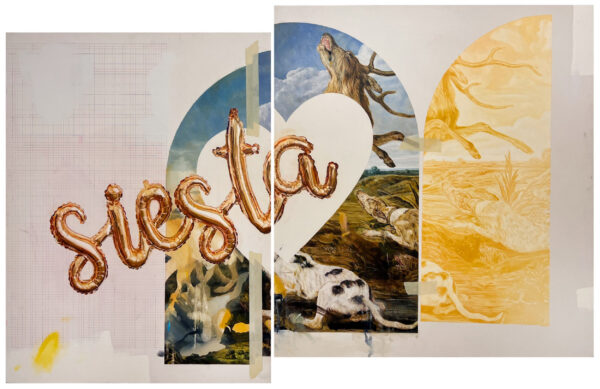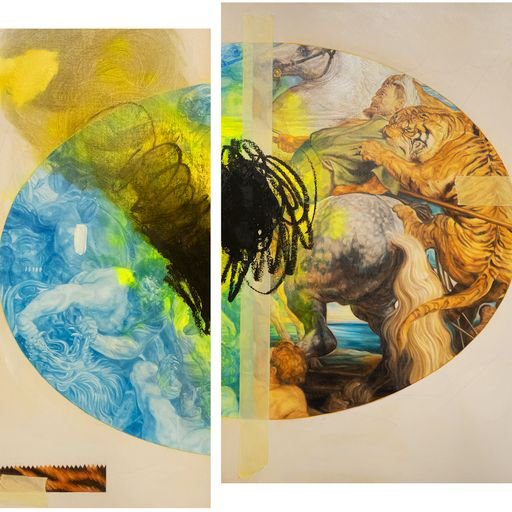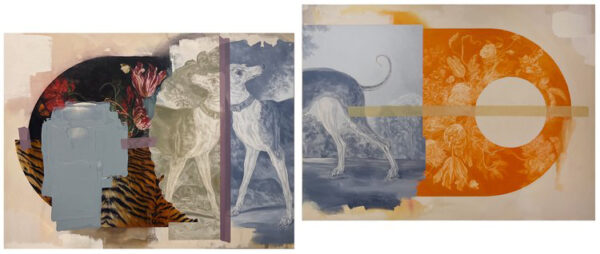The strangest element in any of Adde Russell’s paintings that were recently displayed at Lockhart’s Commerce Gallery is also perhaps the key to understanding the entire group. These mid-sized oil paintings are, overall, most notable for the strange yet highly accomplished re-renderings that Russell performs of works by select old masters. The reference images are duplicated, flipped, and sometimes reduced to monochrome. Then Russell inserts them, as fragments, into much more contemporary frame-paintings complete with trompe l’oeil blue tape, zebra print, and party streamers. This clash alone is enough to stir feelings of art historical dissonance, yet modernity lives here as essentially trivial studio detritus. Why, then, do Russell’s paintings feel as if they are invested in much more complex challenges than how to square old interests with new tastes?
For answers look to Disco Nap, a two-panel piece that reconfigures a 1650 painting by the Flemish Paul de Vos called Stag Hunt. In that work, a pack of dogs encircles and tears into a grimacing stag in front of a cloudy and somewhat barren landscape. Disco Nap places Stag Hunt into an arch that straddles the gutter between the two canvases. It is full-color, but with much of the original’s murk removed. It’s as if Paul de Vos has been remastered. A sliver of Stag Hunt is duplicated off to the right, all in yellows, a reinterpretation that seems, on a technical level, so hard to accomplish. The two versions of Stag Hunt are “held together” with “masking tape” (paint).
Then it gets weird: The majority of the full-color stag is obscured by a big white heart, like a cutout from the image. In front of the heart, painted with predictably impressive veracity, is a string of those garish gold foil letter-shaped balloons that people use at wedding showers, the ones that come in different letters, the ones that read really easily on Instagram. But the thing with those is that you can buy any letter, so that you can spell any word. Russell depicts hers in cursive, letters strung together, one long balloon that says siesta. It’s like a fragmented memory of the real thing.
“Siesta” was the only text in the entire exhibit, and visitors encountered Disco Nap almost immediately upon entering the gallery. This curatorial choice intensifies the significance of this painting within the room.
A google of “letter balloons,” reveals endless variations on the type of gold inflatables Russell references in Disco Nap. In two of the first four ads, the balloons type out #ONTREND. A person can buy a hashtag balloon. The object conjures a strong white, hetero, suburban online fantasy. Look for the photographs of couples holding up a helium-filled set that spells BABY. Now, it becomes easy to picture a family visiting Lockhart. Nuclear. Let’s say the dad plays for the Sugarland Space Cowboys. Maybe he’s called Cade. They all eat barbecue and buy a hat. Commerce Gallery is right there on the main drag, so they take a look. Why not? They see Disco Nap and are looking into a mirror.
Not that Russell is pandering. Not at all. Her paintings are nimble. The ready-made, disposable Instagram culture she skews with her Disco Nap balloon is a perfect foil for the 17th and 18th century paintings she distorts throughout. Here is the erosion of all images. It all ends up as sand, but sand is lovely. A quite enjoyable earlier painting on her website depicts a similar cursive balloon that reads yay. Behind yay is a massive whale shark. Thar be irony.
I have a document on my computer that Russell put together, an illustrated list of all the old master paintings she referenced for her work at Commerce. Are these digital representations somehow less mutated than Russell’s remasterings? As I scroll through the PDF, a superimposed image of a magnifying glass grazes directly over the butthole of the dog in Jean-Baptiste Oudry’s Greyhound (1746). I am sorry, I can’t help but notice. In Russell’s rendering, Let the Rock Roll, the hound appears in duplicate, cheek to cheek in dueling monochromes. As with the PDF menus I still have up and running in another tab, Russell does not allow us to stay steadily with the dog images within her work. They gaze off in opposite directions at the peppered decadence of tiger skins and flower arrangements, the noise that surrounds them painted with as much skill as anything. It verges on sensory overload.
Of course Russell is responding to the contemporary image-environment, because we all are. All of the time. But especially crucial to Let the Rock Roll is a thick, heavily worked, solid slab of grayish paint that obscures a good chunk of the tiger pelt. This is just paint, and it is assertive. In a brilliantly subtle comic move, the gray blob is “attached” to one of the dog images by a semi-transparent strip of purple tape that does not actually hold anything together because it too is just paint. Each of Russell’s paintings is one cumulative, playful, and somewhat subversive action.
Let’s go back to the gold balloon. Perhaps it’s trite to mention, but Russell’s knack for time travel reminds me that artists, like everyone else, are doomed to contend with the times in which they were born. Take the old masters who Russell frequently quotes. If you were a painter back when they were around, you mostly just painted bible stuff, a rich guy, or a Hercules. And you were happy about it. Such parameters no longer exist, but painters like Russell now must acknowledge that their deft renderings will be most frequently viewed as photographs on people’s phones, wedged between shots from Cade’s family album. It’s less than ideal. Russell’s paintings see this, but harness their criticality as a tool to push toward visual delight. They just really need to be experienced in person. In her artist statement, Russell says she appreciates “that what we perceive in our own lives is always shifting.” The sentiment is in the work. What lingers, amazingly, is how often these shifts can be felt over and over again within a single painting.
Adde Russell’s work was on view at Commerce Gallery in Lockhart from August 5-28, 2023.





